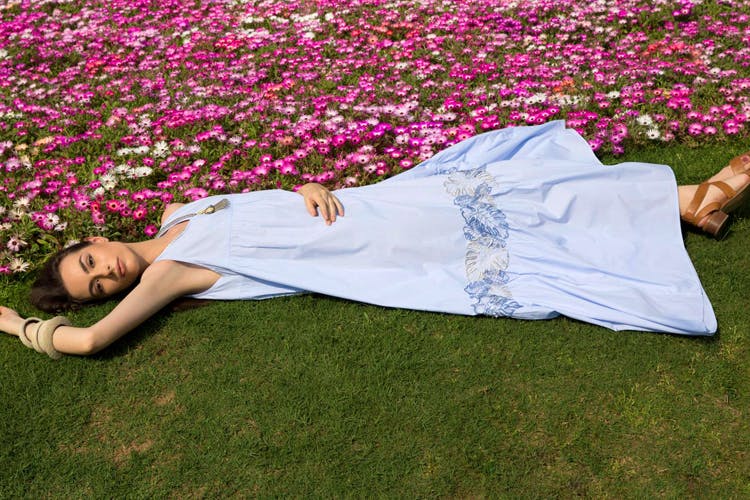Closer to home, we boast a massive handloom heritage, one that is steeped in fabrics, prints, techniques and perennial patterns. So when a new-age designer makes it their prerogative to use it in their design sensibility, we can’t help but celebrate them. Here are nine designers slaying it.
9 Indian Designers Redefining Indian Textiles And Handlooms
Amrich
Retailing stunning separates, Amrich makes a conscious effort to support India’s crafts and craftsmen. They work with traditional craft clusters from around the country, including Bengal, Madhya Pradesh, Uttar Pradesh, Andhra Pradesh and Kutch, incorporating techniques like natural dyeing and printing, resist-dyeing and embroideries.
Amrich, as a brand, uses the intricacies of tie-dye techniques and the vibrant strokes of ikat, with the richness of jamdani and hand embroidery.
Kardo
With fabrics sourced from across the country, each piece from Kardo is designed and conceptualised by Rikki Kher. As for their technique, all products are made in-house by a group of artisans, and they take their process so seriously that each shirt carries a label with the name of the person who made it from start to finish.
Dhruv Kapoor
If you know his aesthetic, you’d know it’s more contemporary than homegrown, including silhouettes, cuts and styling. That said, all his natural fabrics are sourced from the Indian market, including linens, silks and cottons. These fabrics are then worked on to match the brand’s design sensibility.
Tokree
Soft, fusion and Indian women’s wear, their dominant fabric is mulmul {Indian muslin}, where the rest of their fabrics are also rooted in Indian tradition. As for processes, they employ mineral and vegetable dyes, and work closely with the Chippa community for all their prints. Part of their collection includes scarves woven by the Meghal tribe of the Marwar region of Rajasthan.
Eka
Black, white and indigo as dominant colours, easy breezy tunics with pants to match, casual saris, and breathable separates; Eka works with handwoven cottons and linens. All their textiles are sourced naturally from rural and skilled clusters of the weaving belt across West India, and their collection is a manifestation of their basic values of sustainability, timelessness, and individualism.
Soham Dave
Boasting an almost revivalist technique, Soham Dave is dedicated to all things sustainable. One isn’t surprised to learn about the usage of ajrak, Chanderi and khadi styles in their collection. As for where they come from, while ajrak {a unique form of resist printing using hand-carved wooden blocks} is done in Kutch, khadi is sourced from West Bengal, and Chanderi from Madhya Pradesh.
Bodice
Defined by structured, minimalist and androgynous separates, Bodice garments are all engineered in natural and hand-woven textiles, including khaki, cotton and silk, all produced by various artisan groups in India. Their design process is rooted in traditional printing and dyeing techniques, which is always something to own. And by that we mean the product and the process behind it.
Raw Mango
A brand of contemporary Indian hand-woven textiles crafted using traditional techniques, Raw Mango is dedicated to widening the reach of the ultimate indigenous product; the sari. It works with the weavers of Chanderi, Varanasi, and Bengal, and also with the block printers of Akola in Rajasthan. Currently, it is associated with over 350 artisans all committed to the cause of the sari, so much so that each product takes up to seven days to complete.


